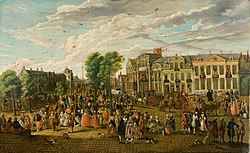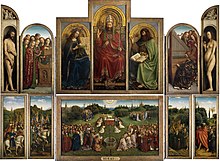Ghent
Ghent (Dutch: Gent [ɣɛnt] ⓘ; French: Gand [ɡɑ̃] ⓘ; historically known as Gaunt in English) is a city and a municipality in the Flemish Region of Belgium.The municipality comprises the city of Ghent proper and the surrounding suburbs of Afsnee, Desteldonk, Drongen, Gentbrugge, Ledeberg, Mariakerke, Mendonk, Oostakker, Sint-Amandsberg, Sint-Denijs-Westrem, Sint-Kruis-Winkel, Wondelgem and Zwijnaarde.[5] Most historians believe that the older name for Ghent, 'Ganda', is derived from the Celtic word ganda, which means 'confluence',[5] or 'river mouth', referring to the Leie river debouching into the Scheldt.[6] There are no written records of the Roman period, but archaeological research confirms that the Ghent area continued to be inhabited.By the 13th century, Ghent was the biggest city in Europe north of the Alps after Paris; it was bigger than Cologne or Moscow.These rich grass 'meersen' ("water-meadows": a word related to the English 'marsh') were ideally suited for herding sheep, the wool of which was used to make cloth.The mercantile zone was so highly developed that wool had to be imported from Scotland and England, which led to Flanders' good relationship with them.High taxes led to a rebellion and eventually to the Battle of Gavere in 1453, in which Ghent suffered a terrible defeat at the hands of Philip the Good.In 1745, the city was captured by French forces during the War of the Austrian Succession before being returned to the Empire of Austria under the House of Habsburg following the Treaty of Aix-la-Chapelle in 1748.After the fusions of municipalities in 1965 and 1977, the city is made up of following sub-municipalities: The climate in this area has mild differences between highs and lows, and there is adequate rainfall year-round.Highlights are St. Bavo's Cathedral with the Ghent Altarpiece, the belfry, the Gravensteen castle, and the splendid architecture along the old Graslei harbour.In the 19th century Ghent's most famous architect, Louis Roelandt, built the university hall Aula, the opera house, and the main courthouse.Highlights of modern architecture are the university buildings (the Boekentoren or Book Tower) by Henry Van de Velde.[14] In Ghent and other regions of East Flanders, bakeries sell a donut-shaped bun called a "mastel" (plural "mastellen"), which is basically a bagel.Stoverij is a classic Flemish meat stew, preferably made with a generous addition of brown 'Trappist' (strong abbey beer) and served with French fries.This campaign is linked to the recognition of the detrimental environmental effects of meat production, which the United Nations' Food and Agriculture Organization has established to represent nearly one-fifth of global greenhouse gas emissions.Also, every five years, an extensive botanical exhibition (Gentse Floraliën) takes place in Flanders Expo in Ghent, attracting numerous visitors to the city.The Ghent University and several research-oriented companies, such as Ablynx, Innogenetics, Cropdesign, and Bayer Cropscience, are situated in the central and southern part of the city.Ghent has the largest designated cyclist area in Europe, with nearly 400 kilometres (250 mi) of cycle paths and more than 700 one-way streets, where bikes are allowed to go against the traffic.In road cycling, the city hosts the start and finish of the Omloop Het Nieuwsblad, the traditional opening race of the cobbled classics season.




















Ghent (disambiguation)FrenchmunicipalityGrasleiVrijdagmarktGravensteenSt. Nicholas' ChurchBelfrySt. Bavo's CathedralBelgiumCommunityFlemish CommunityRegionFlemish RegionProvinceEast FlandersMayor (list)Mathias De ClercqOpen VLDVooruitPostal codesNIS codeArea codesBrusselsAntwerpuniversityScheldtLate Middle Agesnorthern EuropeAfsneeDesteldonkDrongenGentbruggeLedebergMariakerkeMendonkOostakkerSint-AmandsbergSint-Denijs-WestremSint-Kruis-WinkelWondelgemZwijnaardemetropolitan areamayor of GhentGentse FeestenTimeline of GhentStone AgeIron AgeCelticconfluenceGontiaFranksOld DutchSaint AmandabbeysSt. Peter'sBlandiniumSt. Bavo's AbbeyLouis the PiousCharlemagneEinhardVikingsCounty of Flanderscity-stateCologneMoscowwater-meadowsBrugesHigh Middle AgesHundred Years' WarJohn of GauntLancasterDukes of Burgundyled to a rebellionBattle of GaverePhilip the GoodLow CountriesBrabantrevolts against Maximilian of AustriaHouse of HabsburgLucas de HeereJosephJuana of CastileCharles VHoly Roman EmperorRevolt of GhentRoyal SpanishEngelbert van SiclersFerraris mapEighty Years' Warwas capturedWar of the Austrian SuccessionEmpire of AustriaTreaty of Aix-la-ChapelleFlandersAustrian NetherlandsNapoleon INapoleonic WarsCongress of ViennaLieven Bauwensindustrialweaving machineEuropean continentTreaty of GhentWar of 1812Battle of WaterlooViennaUnited Kingdom of the Netherlandsnew connection to the seaBelgian Revolutionworld exhibition in GhentSint-Pieters railway stationWorld War IWorld War II7th "Desert Rats" Armoured Division15th (Scottish) Infantry Divisionsub-municipalitiesWachtebekeLochristiDestelbergenMerelbekeDe PinteSint-Martens-LatemDeinzeLievegemEvergem


